Doc 3: Practice Questions for Abstract Reasoning | Abstract Reasoning for UCAT PDF Download
Abstract Reasoning assesses your ability to identify patterns amongst abstract shapes where irrelevant and distracting material may lead to incorrect conclusions. The test therefore measures your ability to change track, critically evaluate and generate hypotheses and requires you to query judgements as you go along.
You are presented with questions associated with sets of shapes. There are four different question types in this subtest.
Most questions are shown in sets of five, each connected to the same sets of shapes. There are some questions that are standalone. Each question has three or four answer options. You may only select one response. You may be asked to:
- decide whether an example shape belongs to Shape Set A, Shape Set B or Neither;
- select the next shape in a series;
- determine which shape completes a statement;
- decide which shape belongs to a particular Shape Set.
Q.1. You will be presented with two sets of shapes labelled “Set A” and “Set B”. You will be given a test shape and asked to decide whether the test shape belongs to Set A, Set B, or Neither.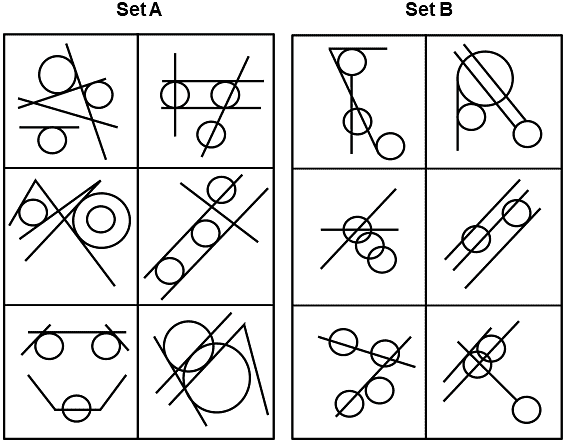
Q. 
(a) Set A
(b) Set B
(c) Neither
Correct Answer is Option (a)
Set A – there are two circles each with two tangents. Other shapes are irrelevant
Set B – there is one circle with two lines transecting it. Other shapes are irrelevant.
Correct Response: A - Two circles with two tangents so Set A.
Q.2. You will be presented with two sets of shapes labelled “Set A” and “Set B”. You will be given a test shape and asked to decide whether the test shape belongs to Set A, Set B, or Neither.
Q. 
(a) Set A
(b) Set B
(c) Neither
Correct Answer is Option (c)
Set A: There is always a black circle in the left-hand column and a square in the right-hand column; at least one square in the box is white.Set B: There is always a circle in the right-hand column and a square in the left hand column; at least one square in the box contains an arrow.
Correct Response: C - This is because all of the shapes in the box are black which does not fit with Set A. None of the squares in the box contains an arrow which does not fit with Set B.
Q.3. You will be presented with two sets of shapes labelled “Set A” and “Set B”. You will be given a test shape and asked to decide whether the test shape belongs to Set A, Set B, or Neither.
Q. 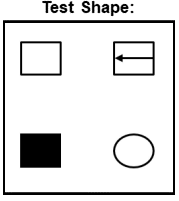
(a) Set A
(b) Set B
(c) Neither
Correct Answer is Option (b)
Set A: There is always a black circle in the left-hand column and a square in the right-hand column; at least one square in the box is white.
Set B: There is always a circle in the right-hand column and a square in the left hand column; at least one square in the box contains an arrow.
Correct Response: B - This is because there is a circle in the right-hand column and a square in the left-hand column. One of the squares in the box contains an arrow which fits Set B.
Q.4. You will be presented with two sets of shapes labelled “Set A” and “Set B”. You will be given a test shape and asked to decide whether the test shape belongs to Set A, Set B, or Neither.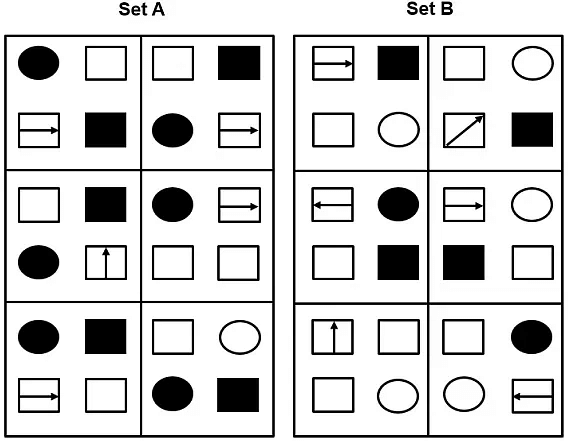 Q.
Q. 
(a) Set A
(b) Set B
(c) Neither
Correct Answer is Option (b)
Set A: There is always a black circle in the left-hand column and a square in the right-hand column; at least one square in the box is white.
Set B: There is always a circle in the right-hand column and a square in the left hand column; at least one square in the box contains an arrow.
Correct Response: B - This is because there is a circle in the right-hand column and a square in the left-hand column. One of the squares in the box contains an arrow which fits Set B.
Q.5. You will be presented with two sets of shapes labelled “Set A” and “Set B”. You will be given a test shape and asked to decide whether the test shape belongs to Set A, Set B, or Neither.
Q. 
(a) Set A
(b) Set B
(c) Neither
Correct Answer is Option (c)
Set A: There is always a black circle in the left-hand column and a square in the right-hand column; at least one square in the box is white.
Set B: There is always a circle in the right-hand column and a square in the left hand column; at least one square in the box contains an arrow.
Correct Response: C - This is because there are four squares in the box which does not fit with any of the sets.
Q.6. You will be presented with two sets of shapes labelled “Set A” and “Set B”. You will be asked to select which of the four response options belongs to Set A or Set B.
Q. Which of the following test shapes belongs in Set A?
(a) 
(b) 
(c) 
(d) 
Correct Answer is Option (c)
Set A: Total number of spots is an ODD number, and larger number of spots is above.
Set B: Total number of spots is an EVEN number, and larger number of spots is below.
Correct response: C - Total number of spots = 13. Larger number of spots (7) is above.
Q.7. You will be presented with two sets of shapes labelled “Set A” and “Set B”. You will be asked to select which of the four response options belongs to Set A or Set B. Q. Which of the following test shapes belongs in Set B?
Q. Which of the following test shapes belongs in Set B?
(a) 
(b) 
(c) 
(d) 
Correct Answer is Option (d)
Set A: Total number of spots is an ODD number, and larger number of spots is above.
Set B: Total number of spots is an EVEN number, and larger number of spots is below.
Correct response: A - Total number of spots = 10. Larger number of spots (7) is below.
Q.8. You will be presented with two sets of shapes labelled “Set A” and “Set B”. You will be asked to select which of the four response options belongs to Set A or Set B.
Q. Which of the following test shapes belongs in Set A?
(a) 
(b) 
(c) 
(d) 
Correct Answer is Option (d)
Set A: Total number of spots is an ODD number, and larger number of spots is above.
Set B: Total number of spots is an EVEN number, and larger number of spots is below.
Correct response: A - Total number of spots = 3. Larger number of spots (2) is above.
Q.9. You will be presented with two sets of shapes labelled “Set A” and “Set B”. You will be asked to select which of the four response options belongs to Set A or Set B. Q. Which of the following test shapes belongs in Set A?
Q. Which of the following test shapes belongs in Set A?
(a) 
(b) 
(c) 
(d) 
Correct Answer is Option (b)
Set A: Total number of spots is an ODD number, and larger number of spots is above.
Set B: Total number of spots is an EVEN number, and larger number of spots is below.
Correct response: B - Total number of spots = 9. Larger number of spots (5) is above.
Q.10. You will be presented with two sets of shapes labelled “Set A” and “Set B”. You will be asked to select which of the four response options belongs to Set A or Set B. Q. Which of the following test shapes belongs in Set B?
Q. Which of the following test shapes belongs in Set B?
(a) 
(b) 
(c) 
(d) 
Correct Answer is Option (d)
Set A: Total number of spots is an ODD number, and larger number of spots is above.
Set B: Total number of spots is an EVEN number, and larger number of spots is below.
Correct Response: D -Total number of spots = 12. Larger number of spots (8) is below.
Q.11. You will be presented with two sets of shapes labelled “Set A” and “Set B”. You will be given a test shape and asked to decide whether the test shape belongs to Set A, Set B, or Neither. Q.
Q. 
(a) Set A
(b) Set B
(c) Neither
Correct Answer is Option (c)
Set A: Each box contains a pair of adjacent circles but no other adjacent pairs.
Set B: Each box contains a pair of adjacent squares but no other adjacent pairs.
Correct response: C - This is because the box contains a pair of adjacent heart shapes which does not fit in any of the rules.
Q.12. You will be presented with two sets of shapes labelled “Set A” and “Set B”. You will be given a test shape and asked to decide whether the test shape belongs to Set A, Set B, or Neither. Q.
Q. 
(a) Set A
(b) Set B
(c) Neither
Correct Answer is Option (b)
Set A: Each box contains a pair of adjacent circles but no other adjacent pairs.
Set B: Each box contains a pair of adjacent squares but no other adjacent pairs.
Correct Response: B - This is because the box contains one pair of adjacent squares but no other pairs which fits the rule for Set B.
Q.13. You will be presented with two sets of shapes labelled “Set A” and “Set B”. You will be given a test shape and asked to decide whether the test shape belongs to Set A, Set B, or Neither. Q.
Q. 
(a) Set A
(b) Set B
(c) Neither
Correct Answer is Option (a)
Set A: Each box contains a pair of adjacent circles but no other adjacent pairs.
Set B: Each box contains a pair of adjacent squares but no other adjacent pairs.
Correct Response: A - This is because the box contains one pair of adjacent circles, but no other pairs which fits the rule for Set A.
Q.14. You will be presented with two sets of shapes labelled “Set A” and “Set B”. You will be given a test shape and asked to decide whether the test shape belongs to Set A, Set B, or Neither.
Q. 
(a) Set A
(b) Set B
(c) Neither
Correct Answer is Option (c)
Set A: Each box contains a pair of adjacent circles but no other adjacent pairs.
Set B: Each box contains a pair of adjacent squares but no other adjacent pairs.
Correct Response: C - This is because there are no adjacent pairs within the box which does not fit any of the rules.
Q.15. You will be presented with two sets of shapes labelled “Set A” and “Set B”. You will be given a test shape and asked to decide whether the test shape belongs to Set A, Set B, or Neither.
Q. 
(a) Set A
(b) Set B
(c) Neither
Correct Answer is Option (c)
Set A: Each box contains a pair of adjacent circles but no other adjacent pairs.
Set B: Each box contains a pair of adjacent squares but no other adjacent pairs.
Correct response: C - This is because there are no adjacent pairs within the box which does not fit any of the rules.
Q.16. You will be presented with two sets of shapes labelled “Set A” and “Set B”. You will be given a test shape and asked to decide whether the test shape belongs to Set A, Set B, or Neither.
Q. 
(a) Set A
(b) Set B
(c) Neither
Correct Answer is Option (b)
Set A: Each box contains a pair of adjacent circles but no other adjacent pairs.
Set B: Each box contains a pair of adjacent squares but no other adjacent pairs.
Correct Response: B - This is because the box contains one pair of adjacent squares, but no other adjacent pairs which fits the rule for Set B.
Q.17. You will be presented with a statement, involving a group of shapes. You will be asked to determine which shape completes the statement.
Q. Which figure completes the statement?
(a) 
(b) 
(c) 
(d) 
Correct Answer is Option (a)
Rule: The number of sides of the answer shape is equal to the total number of circles in the previous figure. Additionally, the answer shape is divided into equally sized sections—the number of sections is equal to the number of shaded circles in the previous figure.
Correct response: A - The number of sides of the answer shape is four, which is equal to the total number of circles in the previous figure. Additionally, the answer shape has been divided into three equally sized sections, which is equal to the number of shaded circles in the previous shape.
Q.18. You will be presented with a statement, involving a group of shapes. You will be asked to determine which shape completes the statement.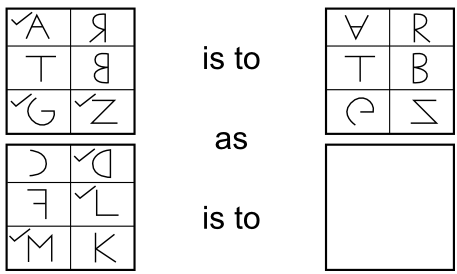
Q. Which figure completes the statement?
(a) 
(b) 
(c) 
(d) 
Correct Answer is Option (b)
Rule: The symbols in the squares with ticks are flipped vertically. Additionally, the symbols in the squares without ticks are flipped horizontally.
Correct response: B - The symbols in the squares with ticks (D, L and M) are flipped vertically. Additionally, the remaining three symbols in the squares without ticks are flipped horizontally.
Q.19. You will be presented with a statement, involving a group of shapes. You will be asked to determine which shape completes the statement.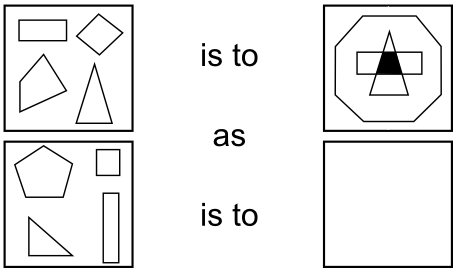
Q. Which figure completes the statement?
(a) 
(b) 
(c) 
(d) 
Correct Answer is Option (b)
Rule: The outermost shape of the answer image has a number of sides equal to the total number of sides of the second shape in the first row and the first shape in the second row in the previous figure. Additionally, the first shape in the first row and the second shape in the second row move to the centre of the shape in the answer image, and the overlapping region is shaded.
Correct response: C - The outermost shape of the answer image has a number of sides (seven) equal to the total number of sides of the second shape in the first row (square) and the first shape in the second row (triangle) in the previous figure. Additionally, the first shape in the first row (pentagon) and the second shape in the second row (rectangle) move to the centre of the shape in the answer image, and the overlapping region is shaded.
Q.20. You will be presented with a series of shapes. You will be asked to select the next shape in series.
Q. Which figure completes the series?
(a) 
(b) 
(c) 
(d) 
Correct Answer is Option (a)
Rule: The arrow rotates 45 degrees clockwise. When the arrow is pointing NE, SE, SW and NW, a dot appears on the tip, but the dot does not appear when the arrow is pointing N, E, S or W.
Correct response: A - This is because the arrow has rotated 45 degrees clockwise to point S and there is no dot on the tip.
|
5 videos|3 docs|4 tests
|
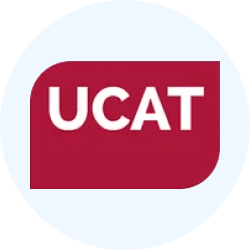
|
Explore Courses for UCAT exam
|

|
















